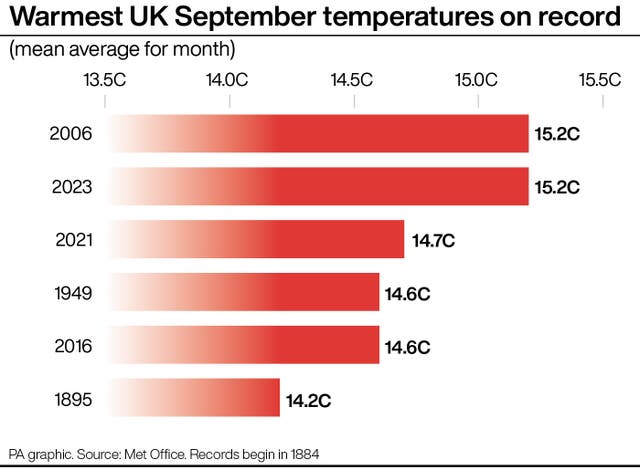Last month was the UK’s joint warmest September on record, provisional figures show.
The average mean temperature across the country was 15.2C, equalling the previous record set in 2006 – something that would have been “practically impossible” without human-led climate change, the Met Office said.
It means five of the top 10 warmest Septembers have taken place this century.
A heatwave affected much of the UK early in the month, with temperatures peaking at 33.2C at Kew Gardens in London on September 9 – the hottest day of the year.
A change in the weather in the second half of September saw storm Agnes bring strong winds and heavy rain to parts of the country, meaning the month ended up wetter than average.

Met Office scientific manager Mark McCarthy said: “This September’s temperature records are heavily driven by how significantly warm the first half of the month was.
“Not only did September have the hottest day of the year – something that has only happened on four previous occasions in our observations – but it also had seven consecutive days where temperatures were above 30C somewhere in the UK, which had never happened in this month in Met Office observations.
“The significantly warm start to September was influenced by high pressure across Europe. This helped to draw warmer air over the UK at the start of the month.”
The Met Office provisional figures show England and Wales both saw their warmest September on record, with mean temperatures of 16.7C and 15.6C respectively, while Northern Ireland had its joint warmest (14.2C) and Scotland its third warmest (12.8C).
Total rainfall for the whole of the UK was 31% above the long-term average, though this pattern was not the same across all parts of the country, with areas of East Anglia and south-east England recording less rain than usual for the month.
Along with 2006 and 2023, the UK’s top 10 warmest Septembers also includes 2021 (14.7C), 2016 (14.6C) and 2014 (13.9C).
Met Office temperature records begin in 1884.
A mean temperature of 15.2C for September would be have been “practically impossible in a climate without human-induced greenhouse gas emissions”, according to Met Office senior scientist Jennifer Pirret.
Research carried out by the organisation’s weather and climate extremes impacts team found that in the current climate, where global temperatures have risen by around 1.1C since the industrial revolution, there is now a 3% chance in a given year of the mean September temperature reaching or exceeding 15.2C.
“While a 3% chance might seem like a small amount, in a pre-industrial climate these temperatures would have been nearly impossible for the UK in September,” Ms Pirret added.
“It shows how climate change is moving the dial on mean temperatures. This September’s temperatures are still unlikely and needed the right combination of large-scale conditions and weather patterns, but climate change has helped to make it possible.
“As global temperatures continue to rise as a result of human greenhouse gas emissions, we expect these chances to increase over the coming decades, though the natural year-to-year variability of the UK climate will obviously continue to play a role.”
